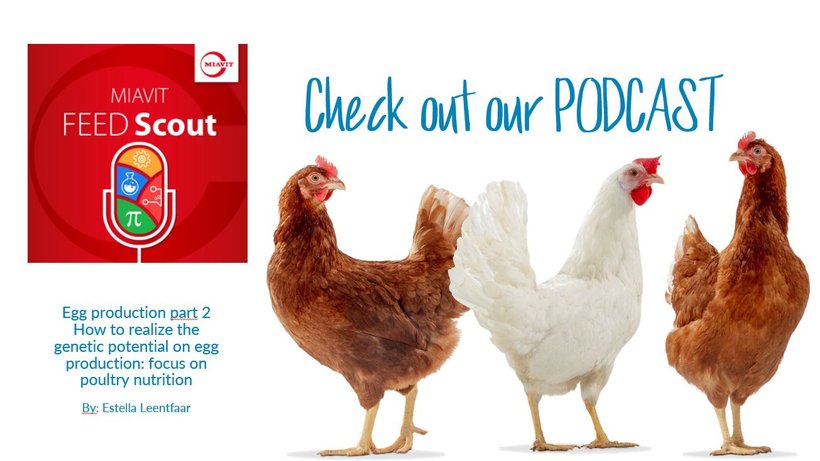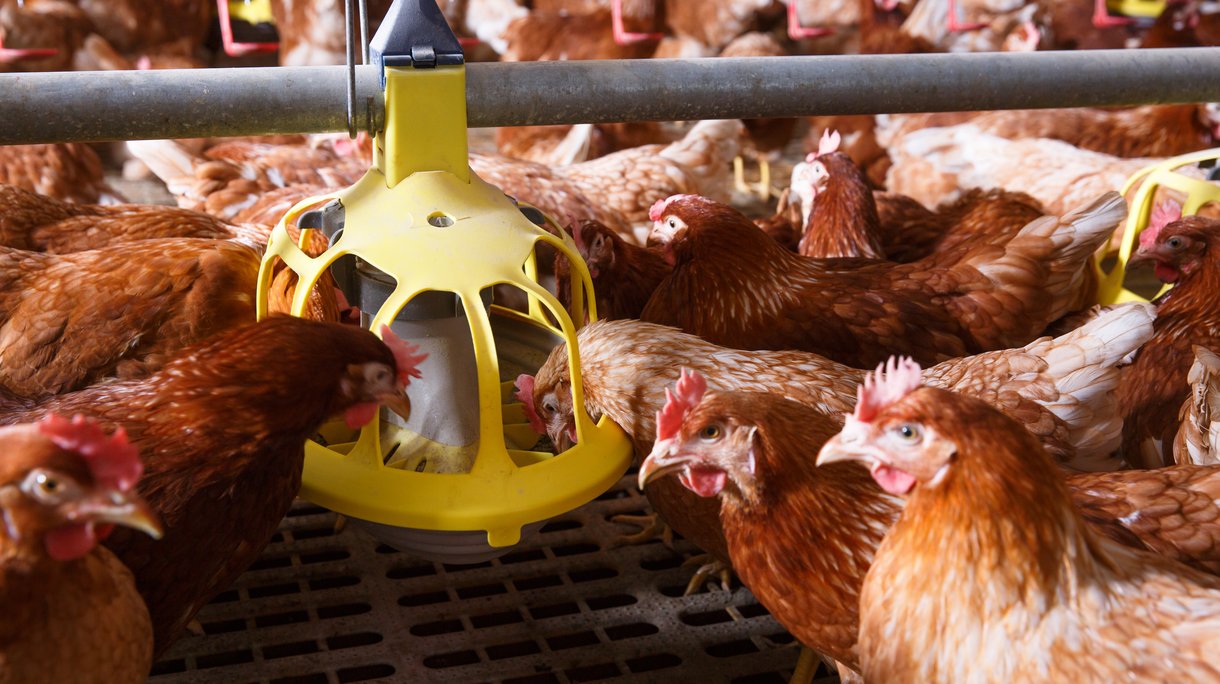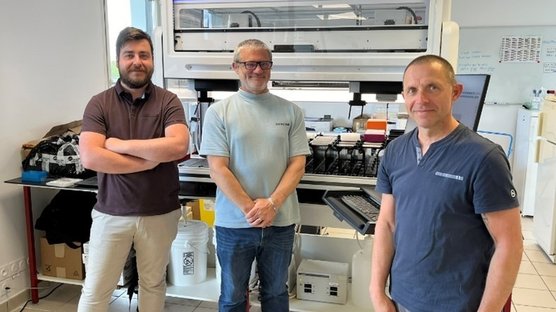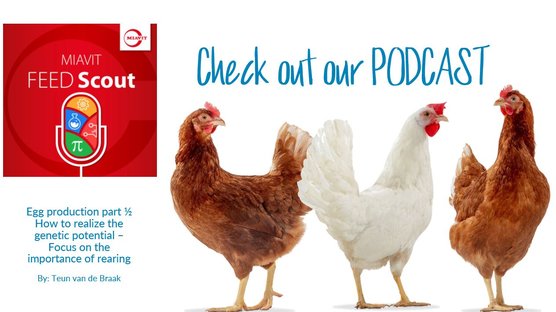
Published on April 26, 2022
Check out the MIAVIT Podcast: How to realize the genetic potential of egg production: focus on poultry nutrition
During the previous MIAVIT Podcast episode we talked about the genetic potential and the importance of a good quality pullet. Today Estella Leentfaar will tell us more about the production period. Estella Leentfaar is one of the poultry nutritionists working for Hendrix Genetics Layers. After her Master in Animal Nutrition from Wageningen University she started working for Nutreco as project manager poultry and as a nutritionist.
In the field we see more often extended production cycles. This is a great benefit for the egg producer! If you can keep your laying hens longer, you will generate more eggs for every laying hen housed. Next to this the impact, or investment of the rearing is getting smaller for every egg being produced. It is my pleasure to provide you today with some background, several tools, tips and tricks about reaching the chickens' genetic potential to it’s fullest during the production period.
Should you adapt nutrition and feed management to realize the genetic potential? First of all, to have a good start, it is important to have a good quality and uniform flock at the start of lay. The higher the uniformity of your flock, the easier to manage your flock and the better your results will be. There are differences between white and brown egg layers: for brown layers we advise to have at least 85% uniformity, for white layers the uniformity should be a bit higher, that is why we recommend at least 90% uniformity.
So when is a pullet really grown out and has reached here final body weight? With 16, 17 or 18 weeks?
We should not forget that laying hens are still growing when they start to lay eggs. In general, we can say that development in body weight continues till 30 to 35 weeks of age. You can imagine, that in the event that the daily nutrient intake is not sufficient, the production can be affected. The daily nutrient intake is the sum of feed composition and feed intake.
To support the daily nutrient intake at the start of egg production, we recommend feeding a diet that is containing higher energy and protein levels. So, your start of lay diet, should be higher in energy and protein compared to the diet fed during the last phase in rearing, the developer diet. As the layer diets contain higher levels of calcium, which does not provide energy or protein. You should either use oils or more concentrated raw materials in the production diets, or use fiber or lower concentrated raw materials in the developer diets, to be able to have higher protein and energy levels at the start of lay compared to the developer diet.
Besides feed composition, you should also focus on feed structure. More coarse diets are easier for the bird to consume and digest. But please make sure the feed is homogenous in its particle size avoiding segregation and selective eating.
How can a farmer protect this birds from selective eating in practice?
Besides having the right feed particle size, there are several management techniques that can help the birds to finish the feed daily. One example of these management techniques is the empty feeder technique. This is general practice to have the feeders empty once a day, preferred timing is around the middle of the day you prevent accumulation of fine feed particles. Those fine particles are extremely essential, as these finer feed particles often includes vitamins, minerals and the amino acids.
Every now and then we hear the liver is important for laying hens. Why is the liver that important for them?
The liver is a large and important organ for laying hens. The liver has several functions in the utilization of nutrients. It is involved in the metabolism of fat, proteins and carbohydrates. Therefore a balanced diet is absolute key: fat and carbohydrates should be used for energy, and protein should be used for protein, i.e. producing eggs. Furthermore, the liver can store some vitamins, mainly the fat-soluble ones. Besides, the liver is important for converting toxins into water-soluble waste products which can be excreted via the kidneys.
So it seems that the liver is also very important for egg production?
We know that the liver is involved in egg mass production. Imagine: when a laying hen is producing 500 eggs, which is proven to be possible in just 100 weeks of age, she will produce over 8.5 kg of egg yolk. Therefore, the liver has a crucial role in the formation of egg yolks and therefore egg production.
The liver has a key role in eggshell formation as well. The liver is involved in the first step of vitamin D3 activation. Vitamin D3 is responsible for calcium absorption and therefore directly impacts egg shell quality.
It seems, after your explanations that the liver is key for assuring production of first quality eggs. So how severe can the fatty liver syndrome affect productivity?
It is known that a fatty liver will result in less egg yolk production and consequently a lower egg mass or less eggs. Furthermore, the activation of vitamin D3 is impaired, which affects the calcium metabolism and consequently results in reduced eggshell quality.
What kind of nutritional factors can affect the liver?
In order to prevent a fatty liver, make sure you monitor the body weight and feed intake of your flock. This already starts with the day-old chick, the pullet growers have a very important role in creating the base for a productive laying hen. Make sure you stimulate body development at start of rearing by high quality nutrition, but do not overfeed them at the end of rearing. We highly recommend to measure body weight development during the production period as well: weekly till 30 weeks of age and monthly from 30 weeks of age onwards.
From a nutritional point of view, make sure you have a well-balance diet including lipotropic factors like Choline, vitamin E and selenium. Lipotropic factors are substances which prevent fat deposition in the liver, or even remove the excess of fat in the liver. Something which sounds a bit contractionary is the usage of oils. For laying hens it is easier to convert oil or fat into fatty acids, than converting starch in fatty acids. A higher level of fat or oil and a lower level of starch will help the liver!
Earlier you mentioned that liver health and vitamin D3 have an effect on egg shell quality, are there any other factors affecting egg shell quality?
By nature the egg produced tomorrow is slightly bigger as the egg that has been produced today. Therefore the eggshell should be divided over a larger surface, resulting in a thinner egg shell. Besides, calcium absorption and utilization decrease when birds are aging. Nevertheless, during a hen’s lifetime, she converts over 1.2 kg of calcium for egg shell production, resulting in over 3 kg of egg shell!
Role of special bones of laying hens
Please be aware that the hens have multiple calcium sources, they can use calcium either via the feed or via the medullary bone. The medullary bone is a third type of bone, which is unique for egg laying animals. Part of the bones have the possibility to store medullary bone which has the purpose to be used as a calcium reservoir. Roughly 30% of the calcium will originate from this type of bone, while the majority will origin from the feed.
Why does a hen need to utilize this calcium reservoir, if there is calcium available in the feed?
Well, eggshell formation takes place mainly during the night period when lights are off. When the lights are off, the hens will not be able to find feed and water, and therefore they will not have access to the calcium in the feed as well. Nevertheless, eggshell formation will continue during this period. Therefore, it is highly recommended to carefully choose your calcium sources.
The main points of attention for calcium quality, are the level of calcium and it’s solubility. With the level of calcium within your calcium source, often a calcium carbonate source like limestone or oyster shells, you can determine the purity of your source and the quantity of calcium your birds are receiving.
Fine limestone, which we define as particles below 0.5 mm, will pass through the digestive system quite fast. This is ideal in the morning, for medullary bone renewal. For eggshell formation, it is recommended to use coarse calcium sources, which we define as particles between 2 and 4 mm. This size of calcium will slowly be dissolved in the gizzard, and consequently absorbed in the intestines. As the dissolving will take a while, calcium absorption will take place even hours after the last feed consumption. This makes calcium longer available during the dark period, when eggshell deposition occurs, but feed is not consumed.
Last but not least, the calcium level. Calcium absorption and utilization are decreasing when aging. As calcium absorption is also partly an active process. Meaning, you can train the hen to use the calcium supply more efficient. So when you are starting off with lower calcium levels, the hen will utilize calcium more efficiently, and consequently will respond better on an increase of calcium at a later age. Therefore, good eggshell quality at the end of the cycle, starts already at an early age!




